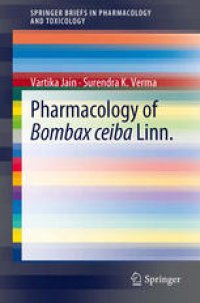
Ebook: Pharmacology of Bombax ceiba Linn.
- Tags: Pharmacology/Toxicology, Complementary & Alternative Medicine, Plant Sciences, Plant Ecology, Pharmacy, Conservation Biology/Ecology
- Series: SpringerBriefs in Pharmacology and Toxicology
- Year: 2012
- Publisher: Springer-Verlag Berlin Heidelberg
- Edition: 1
- Language: English
- pdf
This work is the first monograph devoted solely to Bombax ceiba, popularly known as the Red Silk Cotton Tree. Consisting of seven chapters, it covers all relevant aspects of this plant, from its historical and spiritual importance, to its botanical characterization, pharmacognostical details and ethnobiological uses, to its scientific validation in various animal and human studies. Each part of the tree is of medicinal value and possesses many novel chemical constituents such as shamimicin, bombasin, bombamalone, bombamaloside etc. along with other bioactive secondary metabolites. The book presents the chemical structures of the most important constituents and highlights various pharmacological activities, predominantly antioxidant, anti-inflammatory, anti-mutagenic, hypoglycemic, hypotensive, hepatoprotective and fibrinolytic, which may prove to be a source for the development of a novel phyto-pharmaceutical agent to treat diabetes, heart disease and cancer. In addition, separate chapters deal with the commercial and ecological significance of B. ceiba, as well as a case study on its conservation. Numerous color illustrations are included to identify the plant and to justify its nickname, the “Little Bird’s Cafeteria”.
This work is the first monograph devoted solely to Bombax ceiba, popularly known as the Red Silk Cotton Tree. Consisting of seven chapters, it covers all relevant aspects of this plant, from its historical and spiritual importance, to its botanical characterization, pharmacognostical details and ethnobiological uses, to its scientific validation in various animal and human studies. Each part of the tree is of medicinal value and possesses many novel chemical constituents such as shamimicin, bombasin, bombamalone, bombamaloside etc. along with other bioactive secondary metabolites. The book presents the chemical structures of the most important constituents and highlights various pharmacological activities, predominantly antioxidant, anti-inflammatory, anti-mutagenic, hypoglycemic, hypotensive, hepatoprotective and fibrinolytic, which may prove to be a source for the development of a novel phyto-pharmaceutical agent to treat diabetes, heart disease and cancer. In addition, separate chapters deal with the commercial and ecological significance of B. ceiba, as well as a case study on its conservation. Numerous color illustrations are included to identify the plant and to justify its nickname, the “Little Bird’s Cafeteria”.
This work is the first monograph devoted solely to Bombax ceiba, popularly known as the Red Silk Cotton Tree. Consisting of seven chapters, it covers all relevant aspects of this plant, from its historical and spiritual importance, to its botanical characterization, pharmacognostical details and ethnobiological uses, to its scientific validation in various animal and human studies. Each part of the tree is of medicinal value and possesses many novel chemical constituents such as shamimicin, bombasin, bombamalone, bombamaloside etc. along with other bioactive secondary metabolites. The book presents the chemical structures of the most important constituents and highlights various pharmacological activities, predominantly antioxidant, anti-inflammatory, anti-mutagenic, hypoglycemic, hypotensive, hepatoprotective and fibrinolytic, which may prove to be a source for the development of a novel phyto-pharmaceutical agent to treat diabetes, heart disease and cancer. In addition, separate chapters deal with the commercial and ecological significance of B. ceiba, as well as a case study on its conservation. Numerous color illustrations are included to identify the plant and to justify its nickname, the “Little Bird’s Cafeteria”.
Content:
Front Matter....Pages i-xii
Introduction....Pages 1-10
Ethno-biology....Pages 11-23
Phytochemical Studies....Pages 25-50
Pharmacological Investigations and Toxicity Studies....Pages 51-67
Commercial Importance....Pages 69-72
Ecological Importance and Need of Conservation....Pages 73-87
Future Research....Pages 89-90
Back Matter....Pages 91-94
This work is the first monograph devoted solely to Bombax ceiba, popularly known as the Red Silk Cotton Tree. Consisting of seven chapters, it covers all relevant aspects of this plant, from its historical and spiritual importance, to its botanical characterization, pharmacognostical details and ethnobiological uses, to its scientific validation in various animal and human studies. Each part of the tree is of medicinal value and possesses many novel chemical constituents such as shamimicin, bombasin, bombamalone, bombamaloside etc. along with other bioactive secondary metabolites. The book presents the chemical structures of the most important constituents and highlights various pharmacological activities, predominantly antioxidant, anti-inflammatory, anti-mutagenic, hypoglycemic, hypotensive, hepatoprotective and fibrinolytic, which may prove to be a source for the development of a novel phyto-pharmaceutical agent to treat diabetes, heart disease and cancer. In addition, separate chapters deal with the commercial and ecological significance of B. ceiba, as well as a case study on its conservation. Numerous color illustrations are included to identify the plant and to justify its nickname, the “Little Bird’s Cafeteria”.
Content:
Front Matter....Pages i-xii
Introduction....Pages 1-10
Ethno-biology....Pages 11-23
Phytochemical Studies....Pages 25-50
Pharmacological Investigations and Toxicity Studies....Pages 51-67
Commercial Importance....Pages 69-72
Ecological Importance and Need of Conservation....Pages 73-87
Future Research....Pages 89-90
Back Matter....Pages 91-94
....